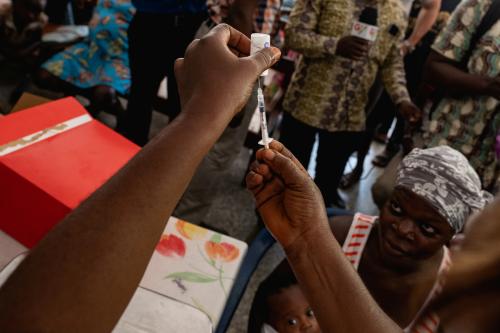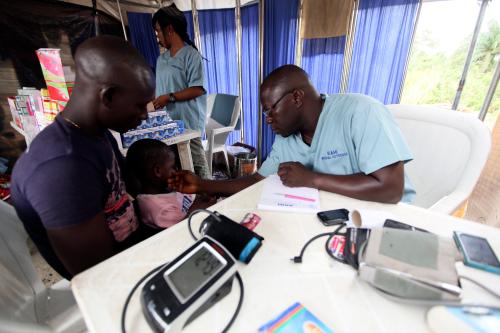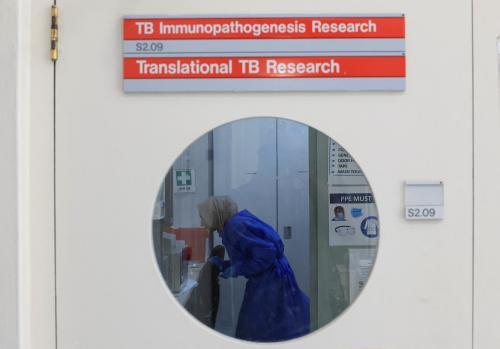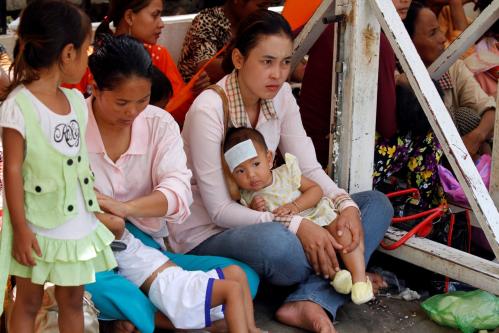Later this month, leaders from across the world will gather in New York for the United Nations General Assembly. During the U.N. High-level Political Forum, the Global Action Plan for healthy lives and well-being for all will launch.
Announced at the 2018 World Health Summit, the Global Action Plan is a historic commitment by 12 major multilateral health and development organizations to join forces to help achieve the Sustainable Development Goals (SDGs). Specifically, signatories to the Global Action Plan agreed to align their efforts, accelerate progress in key areas, and enhance accountability across common targets.
A striking feature of the plan is its call for agencies to enhance their collective efforts in providing global public goods (GPGs) for health. This is good news, because donor agencies have given neither enough attention nor funding to GPGs for health.
We have previously argued that the 2014-2016 Ebola epidemic showed the consequences of this neglect—for example, outbreak surveillance systems performed poorly. The question is whether the next time will be different. Are multilateral agencies ready to collaborate to scale up their support for GPGs for health in a truly joined-up way?
In a new policy analysis led by Duke University’s Center for Policy Impact in Global Health, we set out to answer this question by focusing on the four multilateral organizations that give the most development assistance for health—Gavi, the Vaccine Alliance; the Global Fund to Fight AIDS, Tuberculosis and Malaria (the Global Fund); the World Bank; and the WHO. To do this, we reviewed existing relevant academic and grey literature, strategic and financing documents, and grants and projects databases. We also conducted 46 key informant interviews with senior leaders in these organizations as well as others from think tanks and academia with expertise in GPGs for health and/or the work of these multilateral agencies.
Our analysis points to five key actions these organizations can take individually and collectively to deliver on the Global Action Plan.
Action 1: Adopt an explicit organizational point of view on GPGs for health
All four organizations support GPGs for health in different ways, but there are differences in how clear or explicit each organization is about its support. The Global Action Plan calls for cross-organizational alignment to increase resources and provision of GPGs for health, yet there are inconsistencies in how organizations view their support. Without a clear organizational understanding of each organization’s priorities and programs, cross-organizational alignment and tracking will be difficult.
Action 2: Agree on a common definition of GPGs for health
The health-related SDGs cannot be achieved without supporting GPGs for health but the lack of consensus on a definition of these goods is a barrier to providing such support. We have previously written about the need for such consensus, arguing, “Only an energetic and high profile consensus-building exercise will lead to a widely adopted definition of [global public goods] for health.” The Global Action Plan calls for “collaborating to finance and provide essential GPGs for health.” But without agreement on the scope of this call, it will be difficult to track collaboration or measure its effectiveness in achieving alignment. Multilaterals should define what they mean by collaboration in financing and providing GPGs to ensure they hold themselves accountable to deliver on their pledge. If settling the definitional debate is not feasible in the short term, identifying specific priority goods may be a useful exercise until the organizations can agree on the boundaries of this agenda.
Action 3: Evaluate and jointly share assessments of progress and challenges with existing windows and mechanisms for supporting GPGs for health
All four agencies included in our analysis do have windows or mechanisms to support GPGs for health, e.g., the Global Fund’s Strategic Initiatives and the World Bank’s GPGs window. There is scope for building upon these existing efforts. Evaluating and sharing assessments of these mechanisms will be useful for other organizations contemplating increased or enhanced engagement in GPGs for health. In situations where an organization’s board may be hesitant but the staff are eager to engage, we suggest identifying (a) what information the board would require to engage further on GPGs, and (b) where there are flexibilities in the organization’s structure to expand or adjust support for GPGs within the context of existing programs.
Action 4: Identify a long-term, sustained financing mechanism for GPGs for health
This is needed to overcome the unreliable and fluctuating funding for these goods. The recent launch of new earmarked funding mechanisms for GPGs for health such as the Coalition for Epidemic Preparedness Innovations and of new funding aggregators such as the G-20 Antimicrobial Research and Development Hub show clearly that there has been innovation in funding GPGs for health. Nevertheless, we believe that GPGs for health will ultimately require compulsory collective financing, such as through some form of global taxation (e.g., on fossil fuels or financial transactions).
Action 5: Fund the WHO adequately to provide the overarching governance for GPGs for health
As with global health cooperation more broadly, financing for GPGs for health is fragmented and poorly coordinated, with no clear overarching governance. In addition to the problems laid out above—from a lack of a common definition of GPGs for health to a variation in how explicit organizations are in their GPGs strategy—there is also no “supra-organizational” structure to provide overarching direction and prioritization. Given the WHO’s mandate, it is arguably the best placed of the multilaterals for providing overarching governance for GPGs for health—but to do so it will need a secure, sustained funding stream to support this role.
The Brookings Institution is committed to quality, independence, and impact.
We are supported by a diverse array of funders. In line with our values and policies, each Brookings publication represents the sole views of its author(s).









Commentary
Are the multilaterals ready to act on pandemic prevention and other global public goods?
September 11, 2019